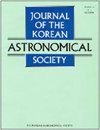新形成的大质量恒星的分子外流
IF 0.8
4区 物理与天体物理
Q3 ASTRONOMY & ASTROPHYSICS
引用次数: 0
摘要
我们在CO J=2 - 1线中绘制了6个大质量年轻恒星天体(yso),并在HCO+ J=1−0、SiO J=2−1、H₂O 6 16−5 23脉泽和CH₃OH 7 0−6 1 A +脉泽线中调查了18个大质量年轻恒星天体(yso)。我们在所有六个映射源中检测到CO双极流出。其中四个是新发现的(07299−1651,21306+5540,22308+5812,23133+6050),而05490+2658是首次在CO J= 2-1线中被映射。探测到的外流比低质量yso(质量bbb20 M⊙,动量>300 M⊙km s−1)的外流质量和能量要大得多。它们的质量流出率(3−6)×10−4 M⊙yr−1,至少比在低质量yso中观察到的大一个数量级。我们分别在18个(100%)和4个(22%)源中检测到HCO+和SiO线发射。HCO +光谱在11个(61%)源中呈现高速翼。我们在13个(72%)源中检测到H₂O脉泽发射,在8个(44%)源中检测到44 GHz CH₃OH脉泽发射。其中5个H₂O和6个CH₃OH脉泽源是新发现的。20081+3122显示高速(bbb30 km s−1)H₂O脉泽线。我们发现,在10−1−10 6 L⊙的热光度范围内,中心(原)恒星的热光度与机械力、机械光度和分子流出物的质量流出率具有良好的相关性,并确定了3个中等或高质量的O类天体。本文章由计算机程序翻译,如有差异,请以英文原文为准。
MOLECULAR OUTFLOWS FROM NEWLY FORMED MASSIVE STARS
We map 6 massive young stellar objects (YSOs) in the CO J=2–1 line and survey 18 massive YSOs, including the six, in the HCO+ J=1−0, SiO J=2−1, H₂O 6 16 − 5 23 maser, and CH₃OH 7 0 − 6 1 A + maser lines. We detect CO bipolar outflows in all the six mapped sources. Four of them are newly discovered (07299−1651, 21306+5540, 22308+5812, 23133+6050), while 05490+2658 is mapped in the CO J=2–1 line for the first time. The detected outflows are much more massive and energetic than outflows from low-mass YSOs with masses >20 M ⊙ and momenta >300 M⊙ km s −1 . They have mass outflow rates (3−6)×10 −4 M ⊙ yr −1 , which are at least one order of magnitude greater than those observed in low-mass YSOs. We detect HCO+ and SiO line emission in 18 (100%) and 4 (22%) sources, respectively. The HCO + spectra show high-velocity wings in 11 (61%) sources. We detect H₂O maser emission in 13 (72%) sources and 44 GHz CH₃OH maser emission in 8 (44%) sources. Of the detected sources, 5 H₂O and 6 CH₃OH maser sources are new discoveries. 20081+3122 shows high-velocity (>30 km s −1 ) H₂O maser lines. We find good correlations of the bolometric luminosity of the central (proto)star with the mechanical force, mechanical luminosity, and mass outflow rate of molecular outflow in the bolometric luminosity range of 10 −1 −10 6 L ⊙ , and identified 3 intermediate- or high-mass counterparts of Class O objects.
求助全文
通过发布文献求助,成功后即可免费获取论文全文。
去求助
来源期刊

Journal of the Korean Astronomical Society
地学天文-天文与天体物理
CiteScore
1.30
自引率
10.00%
发文量
0
审稿时长
>12 weeks
期刊介绍:
JKAS is an international scientific journal publishing papers in all fields of astronomy and astrophysics. All manuscripts are subject to the scrutiny of referees. Manuscripts submitted to JKAS must comply with the ethics policy of JKAS. Six regular issues are published each year on February 28, April 30, June 30, August 31, October 31, and December 31. One year''s issues compose one volume.
 求助内容:
求助内容: 应助结果提醒方式:
应助结果提醒方式:


